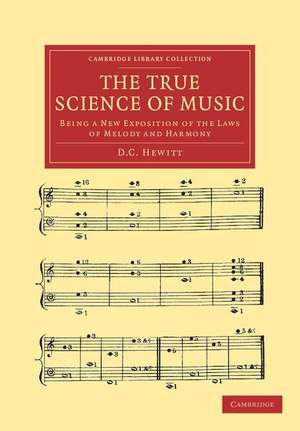The True Science of Music
Being a New Exposition of the Laws of Melody and Harmony
- Author: Hewitt, D. C.
Book
$50.75Printed on demand
Contents
- Preface; Definition of terms; Introduction;
- 1. Sound - notion - vibration - interval;
- 2. Means by which intervals may be obtained and their effects produced, in agreement with their true ratios;
- 3. Description of a series of experiments, and of the phenomena resulting therefrom;
- 4. The unit sound, commonly called the grave harmonic, or generated third sound;
- 5. Systems of sounds;
- 6. On the analysis of chords per-se;
- 7. Of the triune system in respect to chords - that is, harmonic combinations, whence proceed the first, second, and third mode;
- 8. Of the method of finding the ratio of single notes and chords, which appertain to different triune systems - and which, nevertheless, are the same upon keyed instruments, and frequently, though not always, the same in respect to their notation;
- 9. Of the second period of the development of the triune system, whence proceed the harmonics denominated fixed chromatics, and the combinations thence derived;
- 10. Nature - art;
- 11. Explanation of various matters preparatory to the introduction of the musical ratiometer;
- 12. The musical ratiometer, and its connexion with the triune system;
- 13. Analysis of musical phrases and passages extracted from the works of the most celebrated composers, in verification of the triune system, as being the exemplar of what is true and natural in music;
- 14. Of the third period of the development of the triune system, whence proceed the harmonics denominated serial chromatics, and the combinations thence derived;
- 15. Of the great system, or system of systems;
- 16. Of harmonic, basal, and tonic transitions;
- 17. Classification and explanation of principal and subordinate basal transitions;
- 18. Rules relating to melody, harmony, and composition;
- 19. On position. Why the triune system is referred to its central and not to its sub-basis. And on compound vibrations;
- 20. Accent;
- 21. Imitation, fugue, canon;
- 22. Further remarks upon analysis and composition;
- 23. Analysed examples, with strictures;
- 24. Further remarks upon the chord of the diminished or extreme flat 7th. Very low and very high sounds. The number of vibrations in a second, according to the equal temperament. Change of key. A suppositious system of 5 bases. An ideal law of progressio
- 25. New tables of logarithms, and their adaptation to musical purposes. Scale of 53 sounds in the octave. Conclusion; Music examples; Figures and diagrams; The musical ratiometer.



